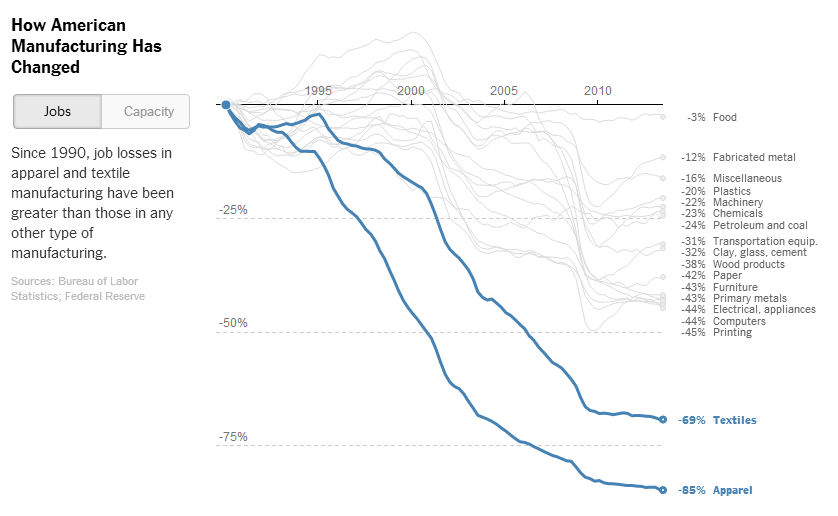The return or rebirth or re-emergence of American manufacturing continues to be a desired if elusive goal. Medium or moderately skilled manufacturing jobs, long the foundation of much of the American middle class, have been on a long but steady decline over the last several decades.
Check the below chart (from the New York Times) to see some data on the percentage decline in employment in various manufacturing sectors:

The data on job losses since 1990 show the most dramatic decreases in employment in textiles and apparel. Which makes sense just by thinking about how the vast majority of the clothes we buy and wear are made somewhere else. The history and reasons for this shift to overseas import of textiles and apparel are pretty well understood - manufacturers relocated operations and increased capacity in low and even lower wage places in the world - China, India, Bangladesh, and so on.
But as the recent New York Times piece "U.S. Textile Plants Return, With Floors Largely Empty of People" does a great job of documenting, even textile and apparel manufacturing can return to the United States, provided that the conditions whereby the American companies can compete, chiefly increased automation thus reducing 'people' costs, are in place.
In the piece (which is kind of long, but you should read it all anyway), we see how textile plants in South Carolina are re-opening and even expanding their capacity as the advances in technology and automation, coupled with the logistical benefits of being able to produce where the customers want to sell, are enabling this rebirth or renaissance of sorts.
Except that the 'rebirth' requires many fewer people than in the heyday of American manufacturing.
From the NYT piece:
American manufacturing has several advantages over outsourcing. Transportation costs are a fraction of what they are overseas. Turnaround time is quicker. Most striking, labor costs — the reason all these companies fled in the first place — aren’t that much higher than overseas because the factories that survived the outsourcing wave have largely turned to automation and are employing far fewer workers.
But as manufacturers find that American-made products are not only appealing but affordable, they are also finding the business landscape has changed. Two decades of overseas production has decimated factories here. Between 2000 and 2011, on average, 17 manufacturers closed up shop every day across the country, according to research from the Information Technology and Innovation Foundation.
Now, companies that want to make things here often have trouble finding qualified workers for specialized jobs and American-made components for their products. And politicians’ promises that American manufacturing means an abundance of new jobs is complicated — yes, it means jobs, but on nowhere near the scale there was before, because machines have replaced humans at almost every point in the production process.
Take Parkdale: The mill here produces 2.5 million pounds of yarn a week with about 140 workers. In 1980, that production level would have required more than 2,000 people
It is a story I think we are going to continue to see - automation and robots and logistics are going to conspire to make 'Made in America' a more commonly seen tagline on all kinds of products.
But this new 'Made in America' will be far different than what many of us remember - when the colossus' of American manufacturing companies employed veritable armies of workers to churn out the products for the domestic and export markets.
It is amazing and incredible to read a story like the Times piece that describes just how some American manufacturers are coming back, and are on par competitively with anyone else in the world. But we also need to remember that just taking the one example from the Parkdale mill, what used to be the work of 2,000 is now the work of 140.
Those 140 jobs have indeed come back.
There are 1,860 that are almost certainly never coming back.
Have a great weekend!